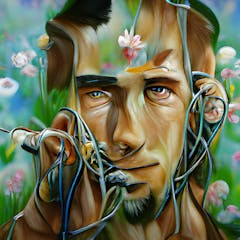
Articles on Visual art
Displaying 1 - 20 of 318 articles

Archie Moore is the first Australian to win the Golden Lion at the Venice Biennale, given to the best national pavilion at the world’s oldest and most renowned art biennale.

Nine artists have taken part in a snorkelling artists’ residency that began underwater in Scotland.

An expansive Queensland Art Gallery survey show of lyrical Indigenous artist Judy Watson, mudunama kundana wandaraba jarribirri, is both thought provoking and stunningly beautiful.

Wanneroo Regional Art Gallery, north of Perth, is showing 53 artworks by Andy Warhol. It’s a far cry from the art meccas – and his work is all the more powerful for it.

The 24th edition of the Biennale of Sydney, titled Ten Thousand Suns, is an explosion of joy and creative energy across seven venues.

The three separate exhibitions that come together in Tales of Land & Sea, speak to ancient myths that still speak to humanity.

Fairy Tales focuses on how artists, designers and filmmakers have taken inspiration from fantasy motifs, adapting the fairy tale vocabulary of extremes to their own artistic needs.

Tactia Dean works across film, photography, drawing, printmaking, immersive installations, and she is now on display at Sydney’s Museum of Contemporary Art.

London-based experiential art collective Marshmallow Laser Feast’s Works of Nature is clearly in the business of knowledge transfer: it tells, it doesn’t ask.

Vincent Namatjira, a Western Arrernte artist, is Albert Namatjira’s great-grandson. His genre is portraiture, but with a twist: loaded with satire and post-colonial politics.

An obscure Mexican engraver named José Guadalupe Posada created the satirical skull in the early 1900s and sold it for a penny. But after he died, it took on a life of its own.

Photography: Real and Imagined at the National Gallery of Victoria can be interpreted as an attempt to make sense of photography’s history.

For Zoe Leonard, photography is not just about using a camera. Photography is also about a way of thinking, seeing and interacting.

Hoda Afshar is one of Australia’s most significant photo media artists. A Curve is a Broken Line at the Art Gallery of New South Wales is her first major survey exhibition.

Pain in a thousand stitches; depicting a society where women live in constant fear of being attacked.

This new show at the Powerhouse Museum reflects the chaos of the digital world and the ubiquity of digital tracking.

In You’ll Know It When You Feel It at the Institute of Modern Art, Raphaela Rosella and her co-creators have sought to reclaim and counteract the narratives formed by state records.

Intellectual property law wasn’t written with AI in mind, so it isn’t clear who owns the images that emerge from prompts – or if the artists whose work was scraped to train AI models should be paid.

Using found materials from dump sites, the large scale works examine the residues of colonialism.

Images of the 2011 tsunami did not look as I had expected, and pointed to the sublime, when experience exceeds our frameworks of understanding. My exhibit ‘Salients’ treats this theme.





